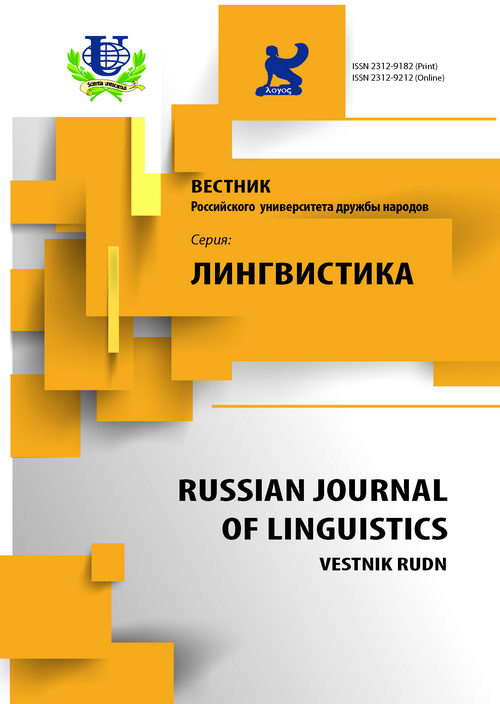The Equivalence and Adequacy Concepts in Teaching Translation at Modern University
- Authors: Lipatova VV1, Litvinov AV1
-
Affiliations:
- University of the Russian Academy of Education
- Issue: No 4 (2011)
- Pages: 105-113
- Section: Articles
- URL: https://journals.rudn.ru/linguistics/article/view/9798
Cite item
Full Text
Abstract
This article covers some basic issues that have to do with the modern equivalence and adequacy notions interpretation when teaching translation at institutions of higher learning. The authors have respect to the research of both native and foreign linguists thus presenting a more comprehensive picture of these concepts content along with distributing the implications between them.
Keywords
About the authors
V V Lipatova
University of the Russian Academy of Education
Email: vilipatova@yandex.ru <mailto:vilipatova@yandex.ru>
Кафедра перевода английского языкаФакультет иностранных языков; Университет Российской академии образования; University of the Russian Academy of Education
A V Litvinov
University of the Russian Academy of Education
Email: alisal01@yandex.ru <mailto:alisal01@yandex.ru>
Кафедра иностранных языков с преподаваниеминостранного языка как общеобразовательной дисциплиныФакультет иностранных языков; Университет Российской академии образования; University of the Russian Academy of Education
References
- Алексеева И.С. Введение в переводоведение. - СПб., 2004.
- Виноградов В.С. Введение в переводоведение (общие и лексические вопросы). - М.: Издательство института общего среднего образования РАО, 2001.
- Бархударов Л.С. Язык и перевод. Вопросы общей и частной теории перевода. - М., 2008.
- Дюришин Д. Межлитературные формы художественного перевода // Проблемы особых межлитературных общностей. - М., 1993.
- Комиссаров В.Н. Современное переводоведение. - М., 2002.
- Найда Ю.А. К науке переводить // Вопросы теории перевода в зарубежной лингвистике. - М., 1978. - С. 99-114.
- Найда Ю.А. Наука перевода // Вопросы языкознания. - 1970. - № 4. - С. 57-63.
- Основные понятия переводоведения: Отечественный опыт / Терминологический словарь-справочник. - М.: РАНИОН, 2010. - С. 220-221.
- Попович А. Проблемы художественного перевода. - М.: Высшая школа, 1980.
- Швейцер А.Д. Теория перевода: Статус, проблемы, аспекты. - М.: Наука, 1988.
- URL: <http://www.fido7.net/cgi-bin/forumm.fpl?user=Image&num=168>. Ригби Э. Адекватный перевод: что это такое и когда он невозможен.
- Arntz R. Terminological Equivalence and Translation // Sonneveld H., Loening K. Terminology: applications in interdisciplinary communication. - Amsterdam: John Bendjamins, 1993. - P. 5-19.
- Baker M. In Other Words: A Coursebook on Translation. - L. and N.Y.: Routledge, 1992.
- Bassnett S. Translation Studies / Literary Theory / Linguistics. Third Edition. - L. and N.Y.: Routledge. Taylor&Francis Group, 2005.
- Catford J.C. A Linguistic Theory of Translation: An Essay in Applies Linguistics. - L., 1965.
- Hann M. The Key to Technical Translation. - Amsterdam & Philadelphia, 1992.
- Kade O. Zufall und Gesetzmäßigkeit in Übersetzung. - Leipzig, 1968.
- Kenny D. Eqivalence / M. Baker. Routledge encyclopedia of translation studies. - N.Y., 1998, 2001. - P. 77-80.
- Koller W. Equivalence in Translation Theory // Ed. A. Chesterman, Readings in Translation Theory. - Helsinki: Oy Finn Lectura Ab., 1989. - P. 99-104.
- Koller W. The Concept of Equivalence and the Object of Translation Studies, 1995. - Target 1 (2). - P. 191-222.
- Newman A. Translation Equivalence: Nature / Ed. R.E. Asher, J.M.Y. Simpson. The Encyclopedia of Language and Linguistics. - Oxford & N.Y.: Pergamon Press, 1994.
- Nida E.A. Toward a Science of Translating. - Leiden, E.J. Brill, 1964.
- Nida E. The theory and practice of translation. - Leiden: Brill, 1969.
- Nida E.A., Taber C.R. The Theory and Practice of Translation, Leiden: E.J. Brill, 1969/1982.
- Touri G. In Search of a Theory of Translation. - Tel Aviv: Porter Institute, 1980.
- Vinay J.P. and Darbelnet J. Comparative Stylistics of French and English: a Methodology for Translation. - Amsterdam / Philadelphia: John Benjamins, 1995.

















